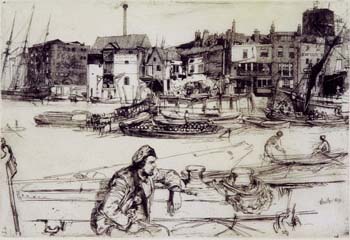Black Lion Wharf
- 1859
- James Abbott McNeill Whistler (American 1834-1903)
- Etching and drypoint, from A Series of Sixteen Etchings of Scenes on the Thames and Other Subjects or "The Thames Set"
15.2 x 22.4 cm., 6 x 8-3/4" image
- Catherine Carter Goebel, Paul A. Anderson Chair in the Arts Purchase, Paul A. Anderson Art History Collection, Augustana College 2002.16

Essay by Margaret Maksimovich, Class of 2010
The year 1859 found American expatriate artist, James Abbott McNeill Whistler, sketching in the East End of London along the Thames River amongst the working class. Here he gained material for A Series of Sixteen Etchings of Scenes on the Thames and Other Subjects, a series that would come to be known as The Thames Set. In this set, he recorded the colorful haunts along the Thames, soon to be erased through modernization that entailed building an embankment. Similar views in Paris, recorded by Charles Meryon, likely inspired Whistler to similarly immortalize such traditional scenes before they disappeared. This set of etchings was completed in 1861 and was positively received by critics of the time, who appreciated Whistler's evident skill in the medium (MacDonald, de Montfort, and Thorp). Black Lion Wharf has become one of the most popular etchings in the series and must have been a favorite of the artist's in that it was included in the background of his iconic painting, Arrangement in Grey and Black: Portrait of the Artist's Mother (1871).
In Black Lion Wharf, Whistler effectively captured the essence of the gritty, grimy dock areas that he experienced while immersed in this environment along the Thames River. He utilized his skill in etching to convey a sense of space and depth in Black Lion Wharf, as evidenced by his using different techniques to separate the foreground and background. The main subjects, a seated man and his surroundings, are boldly outlined in the foreground. His size suggests both his importance and his proximity to the viewer, and the sketchy quality of the lines may indicate movement or action. Conversely, the detail and definition of the buildings in the background provide a sense of permanency, while their diminished scale indicates visual distance.
Very little definition was included on the water's surface which thus affords a visual break in the work. The figures in the middle ground are represented in less detail to suggest that they are of lesser importance to the main figure. When viewed as a whole, the delicate details such as smoke from a chimney in the background offset the bold, dark lines in the foreground and make a cohesive composition. In combination, the effects of these various elements communicate the picturesque nature of everyday scenes. Whistler ultimately came to be regarded as the greatest etcher since Rembrandt van Rijn (web gallery 26 and 27).
